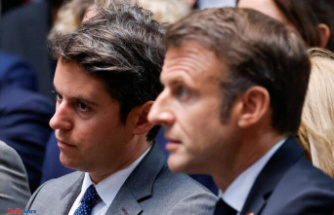According to information from US secret services, the traces of the bomb attacks on the two Nord Stream pipelines lead to Ukraine. Their leadership denies responsibility. Russia does not like to believe the reports anyway and suspects the masterminds to be official.
Ukraine has denied reports of possible involvement in the demolition of the Nord Stream gas pipelines in the Baltic Sea in September. Ukraine has "nothing to do with the incident in the Baltic Sea and has no information about 'pro-Ukrainian sabotage groups'," Ukrainian presidential adviser Mikhail Podoliak wrote on Twitter.
The "New York Times" ("NYT") had reported that, according to the US government, a pro-Ukrainian group was behind the bomb attack. According to several anonymous US government officials, citing new intelligence information, Ukrainian or Russian citizens are probably responsible. There are no indications of an involvement of the Ukrainian President Volodymyr Zelenskyj or his close circle.
Russia saw the new reports as an attempt to distract from the true masterminds. "It is simply a means of throwing suspicion at some abstract person from those in official government positions who ordered and coordinated the attacks in the Baltic Sea," the Russian embassy in the United States told Telegram. "We cannot and do not want to believe in the impartiality of the conclusions drawn by US intelligence agencies."
Meanwhile, according to a report by "Zeit", research by the German media provided insights into the preparation of the bomb attack. Joint research with the ARD capital studio, the ARD political magazine "Kontraste" and the SWR had shown that German investigative authorities had largely reconstructed how and when the bomb attack on the Nord Stream 1 and 2 pipelines was prepared. Accordingly, the tracks lead to Ukraine. However, the client remained unclear.
In September, the explosions in the economic zones of Sweden and Denmark in the Baltic Sea caused several leaks in the Nord Stream 1 and Nord Stream 2 pipelines, which were built to transport Russian gas to Germany. The pipelines were not operating at the time of the explosions but contained gas. According to Sweden, explosive residues were detected.
Russia itself was suspected of being behind the alleged sabotage. The Russian government firmly denied this and pointed the finger at Washington. Years ago, the US government had condemned the construction of Nord Stream 2 as a geopolitical means of pressure from the Kremlin.
At the beginning of February, the well-known US investigative reporter Seymour Hersh caused a sensation with a report according to which US Navy divers had already planted explosive devices on the gas pipelines in June. These were remotely detonated in September. The US government has firmly denied this. Independent fact-checkers have pointed out inconsistencies in the Hersh report.












